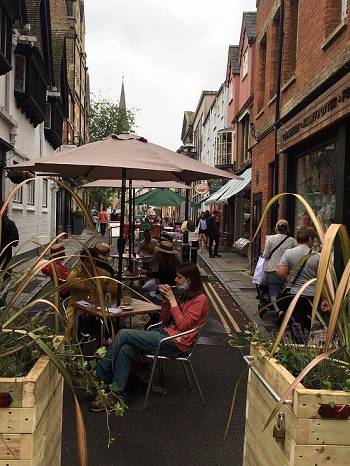To support businesses and protect jobs in the face of restrictions and some customer concerns, post-COVID 19 lockdown, Oxford City Council worked with Oxfordshire County Council as the highways authority, and with its hospitality sector to create an on-street outside tables & chairs offer. This successful approach, which has helped safeguard jobs and maintain the vitality of the city centre, has now been extended into the autumn and winter.
The challenge
As Oxford city centre and its businesses reopened over summer 2020, following closure due to the COVID-19 lockdown, the City Council realised the importance of reacting swiftly to safeguard its hospitality sector. City centre cafes and restaurants are normally the lifeblood of the social and visitor economies. Instead, social distancing measures meant these were amongst the businesses facing the most profound challenges in operating viably and surviving.
As winter comes around and city centre businesses prepare for the run-up to Christmas, the City Council has recognised that the challenges and need for a coordinated response remain. The autumn and winter responses has built on the experiences, learning and feedback on a pilot programme to support alfresco hospitality in Oxford city centre.
The solution
Oxford City Council’s successful summer response saw the part-pedestrianisation of the busy George Street during August and September as a trial. This was developed based on learning from the provision of outside seating areas in adjacent city centre streets. This was achieved in a three-week flurry of activity to prepare the street which included working closely with bus companies to re-route services away from a busy transport hub.
There was a huge amount of learning over the summer, especially in relation to practicalities of traffic management with the support of Oxfordshire County Council. Clear communications, proactive engagement and adaptation alongside stakeholders, was also key. The city’s promotion and profile for its work, has also led to international exchanges of good practice providing pointers for the next phase.
Internally, although the alfresco approach was largely new to Oxford’s City Centre Management Team, it was enabled by an empathy and existing engagement with local businesses. Cross-departmental working involving licensing, safer oxford, markets, highways, street scene, waste, planning, legal, sustainability and communications colleagues that focused on the urgency of issues, has also reinforced a ‘can-do’ culture.
The pedestrianisation projects are just part of the work to support businesses in Oxford through the pandemic. Other work has included creating an ‘open online’ business directory, installing new bike racks across the city and making parking at Oxford’s five park and rides free throughout August and again for much of December to coincide with the second emergence from lockdown.
The impact
In early October, the City Council released the results of a survey that showed that the overwhelming majority of residents and affected businesses supported the summer measures and potential long-term pedestrianisation of some city centre streets. The survey found that 84% of residents said the overall impact of the pilot pedestrianisation was positive, with 85% agreeing that George Street should be pedestrianised permanently.
A selective survey of businesses in George Street revealed that 75% said the overall experience of pedestrianisation for their business was markedly positive. As a direct result of the pedestrianisation, two of the George Street businesses said they hired additional staff, three provided additional hours for their existing staff, and three brought staff back from furlough. Two of the 12 businesses said they only reopened after lockdown because of the pedestrianization; a message that echoed that from a number of other city centre businesses who had argued they could not open viably without outside tables & chairs areas.
How is the new approach being sustained?
As autumn began, the City Council was faced with the dilemma of whether to repeat the exercise in what is likely to be less favourable weather conditions. At the same time, the current medical advice and national trends in consumer sentiment, both backed the continued provision of alfresco hospitality to supplement socially distanced, indoor provision.
The autumn response from Oxford Council’s Restart Team, was once again, not risk averse. Working with the highways authority, the City Council has decided to pedestrianise sections of more streets across the city. The aim again is to support hospitality businesses that needed additional space to operate on a commercial basis whilst maintaining social distancing.
After summer success, the extended schemes are set to run over the winter and beyond. The City Council has extended pedestrianisation and outdoor seating in the central Cornmarket and in St Michael’s Street, and has repurposed parts of the adjacent Broad Street as outside tables & chairs areas. The work has been implemented to support specific hospitality businesses and is expected to remain in place until September 2021.
Lessons learned
Continued learning has been a key part of the development of Oxford city centre’s alfresco hospitality offer in response to COVOD-19. Key consideration and learning points from over the summer, that the City Council take into the autumn arrangements, include:
- The necessity to work closely with Oxfordshire County Council as the highways authority including the application of streamlined procedures for making traffic regulation orders during coronavirus (COVID-19).
- The importance of paying special attention to maintaining vehicle access to loading bays and disabled parking spaces, and allowing for street cleaning, waste collection and deliveries.
- The value of a continued dialogue and flexibility in discussions with bus companies and taxi firms affected by the partial closure of busy thoroughfares.
- The importance of safely incorporating cycle routes alongside alfresco arrangements.
- The benefits of close working relations with local businesses especially around practical considerations for managing outdoor seating.
Contact
Iain Nicholson, City Centre Manager, [email protected]
This case study is part of a suite of resources available as part of the LGA’s revitalising town centres toolkit prepared in association with the People & Places Partnership. This includes links to data tracking national town centre trends on business performance and customer perceptions prepared by People & Places.

